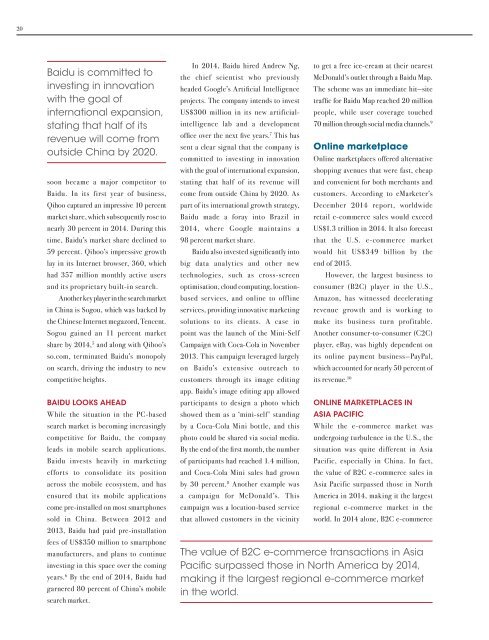SMU_AMI_November_Spread
You also want an ePaper? Increase the reach of your titles
YUMPU automatically turns print PDFs into web optimized ePapers that Google loves.
20<br />
Baidu is committed to<br />
investing in innovation<br />
with the goal of<br />
international expansion,<br />
stating that half of its<br />
revenue will come from<br />
outside China by 2020.<br />
soon became a major competitor to<br />
Baidu. In its first year of business,<br />
Qihoo captured an impressive 10 percent<br />
market share, which subsequently rose to<br />
nearly 30 percent in 2014. During this<br />
time, Baidu’s market share declined to<br />
59 percent. Qihoo’s impressive growth<br />
lay in its Internet browser, 360, which<br />
had 357 million monthly active users<br />
and its proprietary built-in search.<br />
Another key player in the search market<br />
in China is Sogou, which was backed by<br />
the Chinese Internet megazord, Tencent.<br />
Sogou gained an 11 percent market<br />
share by 2014, 5 and along with Qihoo’s<br />
so.com, terminated Baidu’s monopoly<br />
on search, driving the industry to new<br />
competitive heights.<br />
Baidu looks ahead<br />
While the situation in the PC-based<br />
search market is becoming increasingly<br />
competitive for Baidu, the company<br />
leads in mobile search applications.<br />
Baidu invests heavily in marketing<br />
efforts to consolidate its position<br />
across the mobile ecosystem, and has<br />
ensured that its mobile applications<br />
come pre-installed on most smartphones<br />
sold in China. Between 2012 and<br />
2013, Baidu had paid pre-installation<br />
fees of US$350 million to smartphone<br />
manufacturers, and plans to continue<br />
investing in this space over the coming<br />
years. 6 By the end of 2014, Baidu had<br />
garnered 80 percent of China’s mobile<br />
search market.<br />
In 2014, Baidu hired Andrew Ng,<br />
the chief scientist who previously<br />
headed Google’s Artificial Intelligence<br />
projects. The company intends to invest<br />
US$300 million in its new artificialintelligence<br />
lab and a development<br />
office over the next five years. 7 This has<br />
sent a clear signal that the company is<br />
committed to investing in innovation<br />
with the goal of international expansion,<br />
stating that half of its revenue will<br />
come from outside China by 2020. As<br />
part of its international growth strategy,<br />
Baidu made a foray into Brazil in<br />
2014, where Google maintains a<br />
98 percent market share.<br />
Baidu also invested significantly into<br />
big data analytics and other new<br />
technologies, such as cross-screen<br />
optimisation, cloud computing, locationbased<br />
services, and online to offline<br />
services, providing innovative marketing<br />
solutions to its clients. A case in<br />
point was the launch of the Mini-Self<br />
Campaign with Coca-Cola in <strong>November</strong><br />
2013. This campaign leveraged largely<br />
on Baidu’s extensive outreach to<br />
customers through its image editing<br />
app. Baidu’s image editing app allowed<br />
participants to design a photo which<br />
showed them as a ‘mini-self’ standing<br />
by a Coca-Cola Mini bottle, and this<br />
photo could be shared via social media.<br />
By the end of the first month, the number<br />
of participants had reached 1.4 million,<br />
and Coca-Cola Mini sales had grown<br />
by 30 percent. 8 Another example was<br />
a campaign for McDonald’s. This<br />
campaign was a location-based service<br />
that allowed customers in the vicinity<br />
to get a free ice-cream at their nearest<br />
McDonald’s outlet through a Baidu Map.<br />
The scheme was an immediate hit—site<br />
traffic for Baidu Map reached 20 million<br />
people, while user coverage touched<br />
70 million through social media channels. 9<br />
Online marketplace<br />
Online marketplaces offered alternative<br />
shopping avenues that were fast, cheap<br />
and convenient for both merchants and<br />
customers. According to eMarketer’s<br />
December 2014 report, worldwide<br />
retail e-commerce sales would exceed<br />
US$1.3 trillion in 2014. It also forecast<br />
that the U.S. e-commerce market<br />
would hit US$349 billion by the<br />
end of 2015.<br />
However, the largest business to<br />
consumer (B2C) player in the U.S.,<br />
Amazon, has witnessed decelerating<br />
revenue growth and is working to<br />
make its business turn profitable.<br />
Another consumer-to-consumer (C2C)<br />
player, eBay, was highly dependent on<br />
its online payment business—PayPal,<br />
which accounted for nearly 50 percent of<br />
its revenue. 10<br />
Online marketplaces in<br />
Asia Pacific<br />
While the e-commerce market was<br />
undergoing turbulence in the U.S., the<br />
situation was quite different in Asia<br />
Pacific, especially in China. In fact,<br />
the value of B2C e-commerce sales in<br />
Asia Pacific surpassed those in North<br />
America in 2014, making it the largest<br />
regional e-commerce market in the<br />
world. In 2014 alone, B2C e-commerce<br />
The value of B2C e-commerce transactions in Asia<br />
Pacific surpassed those in North America by 2014,<br />
making it the largest regional e-commerce market<br />
in the world.


